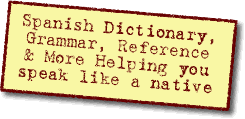Ask a Question(Create a thread) |
|
|||||||
Escucho-osGrammar questions– conjugations, verb tenses, adverbs, adjectives, word order, syntax, etc. |
 |
|
|
Thread Tools |
|
#1
|
|||
|
|||
|
Escucho-os
Hello I want to ask a question
When you say:I listen to you in spanish You say:"Os escucho" so you put the pronoun "os" at the beginning of the sentence.But what if you want to place it at the end:"Escucho-os" I don't know its correct form. Can you help me please?? |
|
Get rid of these ads by registering for a free Tomísimo account.
|
|
#3
|
|||
|
|||
|
ok wrholt thank you so much but I have one more question:
what if you want to conjugate the "escuchar" verb for gerund form.How do you say it:Escuchando?? is it that way? and how do you put the pronoun "os" at the end of this gerund form? is it like "escuchandoos?? I didn't get that. |
|
#4
|
||||
|
||||
|
Quote:
The gerund form of most -er and -ir verbs is formed by removing -er or -ir and adding -iendo. However, if the verb stem (the part that remains after removing -er or -ir) ends in a vowel letter, then one adds -yendo instead. The gerund form of the verb "ir" is "yendo". When you attach one or more object pronouns to the gerund form, you ALWAYS have to write an accent mark over the central vowel of the gerund ending, so that the ending is written -ándo, -iéndo, or -yéndo. By the way, when you are writing/editing a forum message here, you can type the accented letters and other special characters by using the "Accents" dropdown menu from the toolbar above your edit window. |
|
#5
|
||||
|
||||
|
You're talking about the Spanish gerundio in the last couple of posts. This is not called a gerund, as that means something else in English. The translation is 'present participle' and it's not a conjugation of the verb. It's a verbal.

|
 |
«
Previous Thread
|
Next Thread
»
| Link to this thread | |
|
|
|||||||
All times are GMT -6. The time now is 02:15 AM.








 You need a written accent: escuchándoos
You need a written accent: escuchándoos 